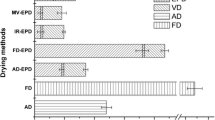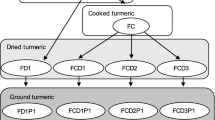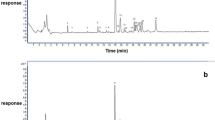Abstract
Lotus root chips were prepared using five different methods (freeze-drying, microwaving, air-frying, oil-frying, and oven-baking), and their quality characteristics, bioactive substance content, and antioxidant activity were determined. The amount of acrylamide generated during manufacturing was determined. The proximate content of the chips varied depending on the manufacturing method. Based on color determination, lightness was highest in freeze-dried chips and lowest in oven-baked chips. Oil-fried chips had the highest redness, yellowness, and browning index. The total polyphenol, flavonoid content, and antioxidant activities were the highest in freeze-dried chips and the lowest in oven-baked chips. Air-fried chips had the highest (746.92 µg/g) acrylamide content, while freeze-dried chips had the lowest (1.82 µg/g). Compared to other methods, freeze-drying retained the maximum bioactive compound content and antioxidant activity, leading to the lowest acrylamide formation. These findings highlight a suitable method and provide basic data for future lotus root chip manufacturing.


Similar content being viewed by others
References
AOAC. Official methods of analysis of AOAC international. 16th ed. Association of official analytical chemists, Washington, DC, USA. Ch. 3. pp 1-26 (1995)
Bagdonaite K, Derler K, Murkovic M. Determination of acrylamide during roasting of coffee. Journal of Agricultural and Food Chemistry. 56: 6081-6086 (2008)
Basaran B, Cuvalcı B, Kaban G. Dietary acrylamide exposure and cancer risk: A systematic approach to human epidemiological studies. Foods. 12: 346 (2023)
Bishayee A, Pater PA, Shara P, Thourtireddy S, Das N. Lotus (Nelumbo nucifera Gaertn.) and its bioactive phytocompounds: A tribute to cancer prevention and intervention. Cancers. 14: 529 (2022)
Cheung LM, Cheung PCK, Ooi VEC. Antioxidant activity and total phenolics of edible mushroom extracts. Food Chemistry. 81: 249255 (2003)
Choi JY, Park J, Kim J, Kim J, Jeong S, Kim M, Park S, Moon KD. Quality characteristics of lotus root (Nelumbo nucifera G.) snacks according to heat treatment methods and conditions. Korean Journal of Food Preservation. 28: 344-355 (2021)
Choi SY, Ko SH, Jeong HC. Antioxidant activities and physicochemical properties of porridge by freeze dried lotus root powder of different ratios. Culinary Science and Hospitality Research. 25: 147-158 (2019)
Chung HW, Park SK, Choi D. Determination of acrylamide in food products. Analytical Science and Technology. 20: 164-169 (2007)
Commission Regulation (EU) 2017/2158 of 20 November 2017. Establishing mitigation measures and benchmark levels for the reduction of the presence of acrylamide in food. [cited 2023 May 22]. Available from: https://eur-lex.europa.eu/legal-content/EN/TXT/PDF/?uri=CELEX:32017R2158&from=EN. Accessed June 2, 2023.
Constantinou C, Koutsidis G. Investigations on the effect of antioxidant type and concentration and model system matrix on acrylamide formation in model Maillard reaction systems. Food Chemistry. 197: 769-775 (2016)
Defraeye T. Towards more efficient intermittent drying of fruit: Insight from combined hygrothermal-quality modelling. Innovative Food Science and Emerging Technologies. 38: 262-271 (2016)
Fakhre NA, Ibrahim B. Acrylamide in potato chips samples using different analytical techniques. Advance in Agriculture and Biology. 2: 50-53 (2014)
Food and Drug Administration. Detection and quantitation of acrylamide in foods. 2003 [cited 2023 Jan 21]. Available from: https://www.fda.gov/food/chemicals/detection-and-quantitation-acrylamide-foods. Accessed Oct 12, 2022.
Han SJ, Koo SJ. Study on the chemical composition in bamboo shoot, lotus root and burdock. Korean Journal of Food and Cookery Science. 9: 82-87 (1993)
Harakotr B, Suriharn B, Tangwongchai R, Scott MP, Lertrat K. Anthocyanin, phenolics and antioxidant activity changes in purple waxy corn as affected by traditional cooking. Food Chemistry. 164: 510-517 (2014)
Hogervorst JG, Schouten LJ. Dietary acrylamide and human cancer; even after 20 years of research an open question. The American Journal of Clinical Nutrition. 116: 846-847 (2022)
Huang B, Ban X, He J, Tong J, Tian J, Wang Y. Hepatoprotective and antioxidant activity of ethanolic extracts of edible lotus (Nelumbo nucifera Gaertn.) leaves. Food Chemistry. 120: 873-878 (2010)
Hwang ES, Lee HK. Quality characteristic, antioxidant activity and acrylamide content of sweet potato chips according to the baking temperature. Journal of the Korean Society of Food Science and Nutrition. 50: 1350-1357 (2021)
Indiarto R, Asyifaa AH, Adiningsih FCA, Aulia GA, Achmad SR. Conventional and advanced food-drying technology: A current review. International Journal of Scientific and Technology Research. 10: 99-107 (2021)
International Agency for Research on Cancer (IARC). IARC monographs on the evaluation of carcinogenic risks to humans-Some industrial chemicals. IARC Publications, Lyon, France. Vol. 60, p. 560 (1994)
Jang JY, Ahn JH, Jo YH, Hwang BY, Lee MK. Antioxidant activity and phenolic content of different parts of lotus and optimization of extraction condition using response surface methodology. Natural Product Sciences. 25: 44-48 (2019)
Jeong DW, Park YK, Nam SS, Han SK. Effect of hot-air drying temperature on antioxidant activity of sweet potato leaves. Korean Journal of Food Preservation. 22: 708-713 (2015)
Kang JH, Yoon SJ. Quality characteristics of Julpyun containing different levels of lotus root powder. Korean Journal of Food and Cookery Science. 24: 392-397 (2008)
Kim YS, Jeon SS, Jung ST. Effect of lotus root powder on the baking quality of white bread. Korean Journal of Food and Cookery Science. 18: 413-425 (2002)
Kim HS, Lee CH, Oh JW, Lee JH, Lee SK. Quality characteristics of sponge cake with added lotus leaf and lotus root powders. Journal of the Korean Society of Food Science and Nutrition. 40: 1285-1291 (2011)
Kim HB, Chung HS, Moon KD. Browning inhibition of fresh-cut lotus roots by blanching in Glycyrrhiza glabra L. and Astragalus membranaceus Bunge extracts. Korean Journal of Food Preservation. 21: 151-156 (2014)
Kim DH, Kang CS. Qualitative characteristics of muffins prepared with freeze dried lotus root powder. Journal of Hotel and Resort. 11: 5-15 (2012)
Krishnakumar T, Visvanathan R. Acrylamide in food products: A review. Food Processing and Technology. 5: 344 (2014)
Lee EJ, Kim HI, Hong GJ. Quality characteristics of cookies added with Nelumbo nucifera G. powder. Korean Journal of the Korean Society of Food Culture. 26: 394-399 (2011)
Lee J, Oh M, Chang YH, Lee Y, Jin YI, Chang DC, et al. Reduction of acrylamide formation in potato chips fermented by Bacillus sp. Journal of Korean Society Food Science and Nutrition. 45: 460-465 (2016)
Liu QL, Yi Y, Wang SQ, Wang HX, Xu W, Min T, Wang LM. Non-enzymatic browning of lotus root during boiling. Food Science and Technology. 173: 114191 (2023)
Liu J, Zhang M, Wang S. Processing characteristics and flavour of full lotus root powder beverage. Journal of the Science of Food and Agriculture. 90: 2482-2489 (2010)
Mesias M, Delgado-Andrade C, Morales FJ. Alternative food matrices for snack formulations in terms of acrylamide formation and mitigation. Journal of the Science of Food and Agriculture. 99: 2048-2051 (2019)
Min T, Lu K, Chen J, Niu L, Lin Q, Yi Y, Hou W, Ai Y, Wang H. Biochemical mechanism of fresh-cut lotus (Nelumbo nucifera Gaertn.) root with exogenous melatonin treatment by multiomics analysis. Foods. 12: 44 (2023)
Ministry of Food and Drug Safety (MFDS). Food information. 2020 [cited 2021 Aug 16]. Available from: https://www.mfds.go.kr/brd/m_511/view.do?seq=33021&srchFr=&srchTo =&srchWord=&srchTp=&itm_seq_1=0&itm_seq_2=0&multi_itm_seq=0&company_cd=&company_nm=&page=1. Accessed May 15, 2023.
Nikolic M, Pavlovic A, Mitic M, Mitic S, Tosic S, Pecev-Marinkovic E, Mrmosanin J. Thermal degradation kinetics of total polyphenols, flavonoids, anthocyanins and individual anthocyanins in two types of wild blackberry jams. Advanced Technologies. 7: 20-27 (2018)
Oyinloye TM, Yoon WB. Effect of freeze-drying on quality and grinding process of food produce: A Review. Processes. 8: 354 (2020)
Park YS, Lee HC, Kim YK, Kang SS, Kang SH, Lee B. Quality characteristics and antioxidant activities of ‘Chuwhangbae’ (P. pyrifolia Nakai) dried with different methods. Korean Journal of Food Preservation. 27: 25-31 (2020)
Rice-Evans CA, Miller NJ, Paganga G. Structure-antioxidant activity relationships of flavonoids and phenolic acids. Free Radical Biology and Medicine. 20: 933-956 (1996)
Sakanaka S, Tachibana Y, Okada Y. Preparation and antioxidant properties of extracts of Japanese persimmon leaf tea (kakinoha-cha). Food Chemistry. 89: 569−575 (2005)
Seo BY, Kim JS, Park E. Comparison of phenolic compounds and antioxidant properties of sweet potato (Imopea batatasL. Lam) according to variety and moist heat cooking. Journal of the Korean Society of Food Science and Nutrition. 47: 243-252 (2018)
Shin DS, Yoo YM, Kim HY, Han GJ. Determine the effects of drying temperature on the quality change and anti- oxidant activity characteristics of blueberry. Korean Journal of Food Preservation. 22: 505-511 (2015)
Showkat QA, Rather JA, Jabeen A, Dar BN, Makroo HA, Majid D. Bioactive components, physicochemical and starch characteristics of different parts of lotus (Nelumbo nucifera Gaertn.) plant: a review. International Journal of Food Science and Technology. 56: 2205-2214 (2021)
Sung WC, Chen CY. Influence of cookies formulation on the formation of acrylamide. Journal of Food and Nutrition Research. 5: 370-378 (2017)
Tareke E, Rydberg P, Karlsson P, Eriksson S, Tornqvist M. Analysis of acrylamide, a carcinogen formed in heated foodstuffs. Journal of Agricultural Food Chemistry. 50: 4998-5006 (2002)
Vasco C, Ruales J, Kamal-Eldin A. Total phenolic compounds and antioxidant capacities of major fruits from Ecuador. Food Chemistry. 111: 816−823 (2008)
Wang Y, Wu X, McClements DJ, Chen L, Miao M, Jin Z. Effect of new frying technology on starchy food quality. Foods. 10: 1852 (2021)
Yodkraisri W, Bhat R. Quality evaluation of deep fried chips produced from lotus rhizome. International Food Research Journal. 19: 1423-1427 (2012)
Yu AN, Li Y, Yang Y, Yu K. The browning kinetics of the non-enzymatic browning reaction in L-ascorbic acid/basic amino acid systems. Food Science and Technology, Campinas. 38: 537-542 (2018)
Acknowledgements
This study was supported by the Basic Science Research Program of the National Research Foundation of Korea (Grant No. NRF-2021R1F1A1060605).
Author information
Authors and Affiliations
Corresponding author
Ethics declarations
Conflict of interest
The authors declare no conflict of interest.
Additional information
Publisher's Note
Springer Nature remains neutral with regard to jurisdictional claims in published maps and institutional affiliations.
Rights and permissions
Springer Nature or its licensor (e.g. a society or other partner) holds exclusive rights to this article under a publishing agreement with the author(s) or other rightsholder(s); author self-archiving of the accepted manuscript version of this article is solely governed by the terms of such publishing agreement and applicable law.
About this article
Cite this article
Hwang, ES., Lee, S. Quality characteristics, antioxidant activity, and acrylamide content of lotus root chips prepared using different processing methods. Food Sci Biotechnol 33, 1371–1379 (2024). https://doi.org/10.1007/s10068-023-01448-1
Received:
Revised:
Accepted:
Published:
Issue Date:
DOI: https://doi.org/10.1007/s10068-023-01448-1




